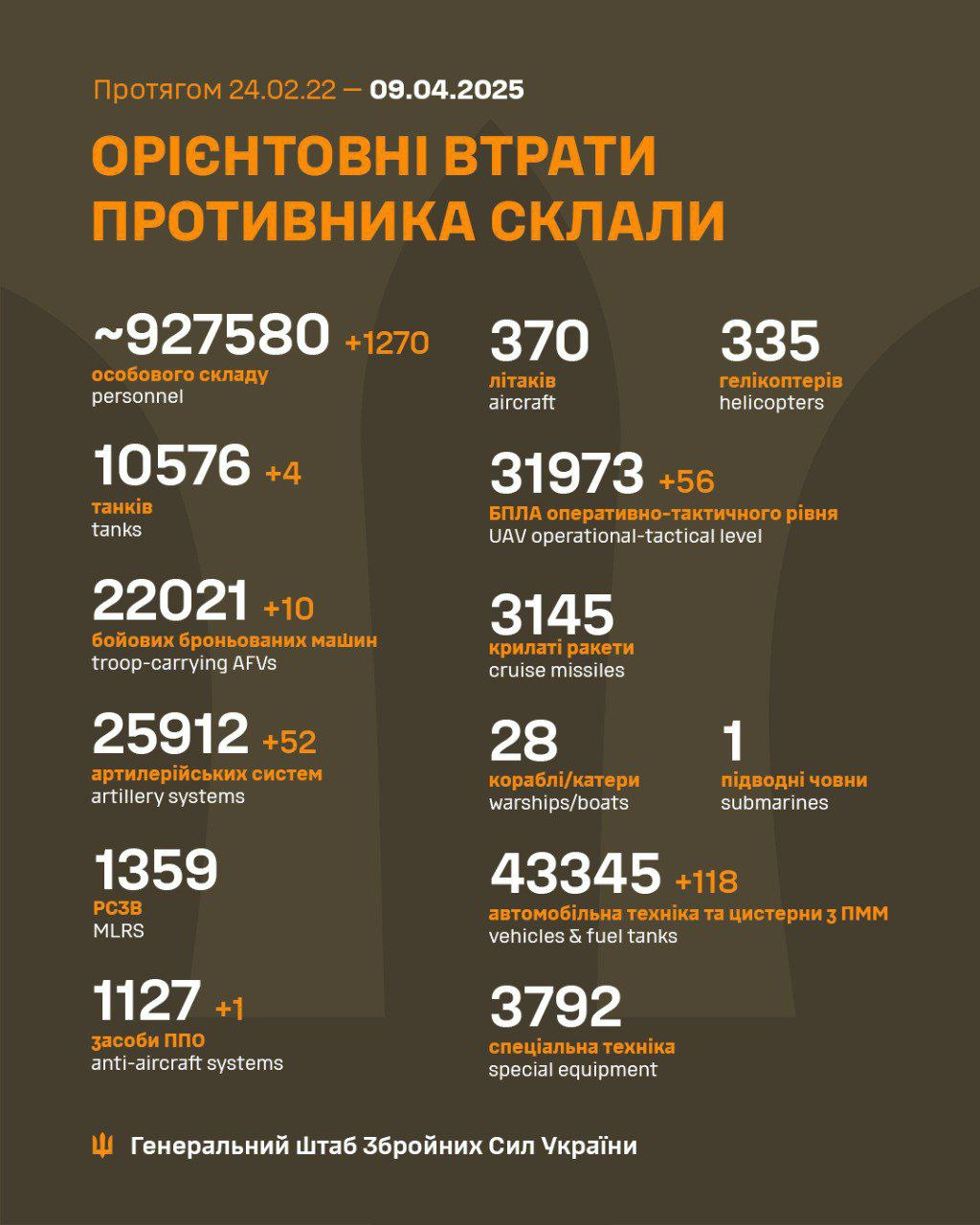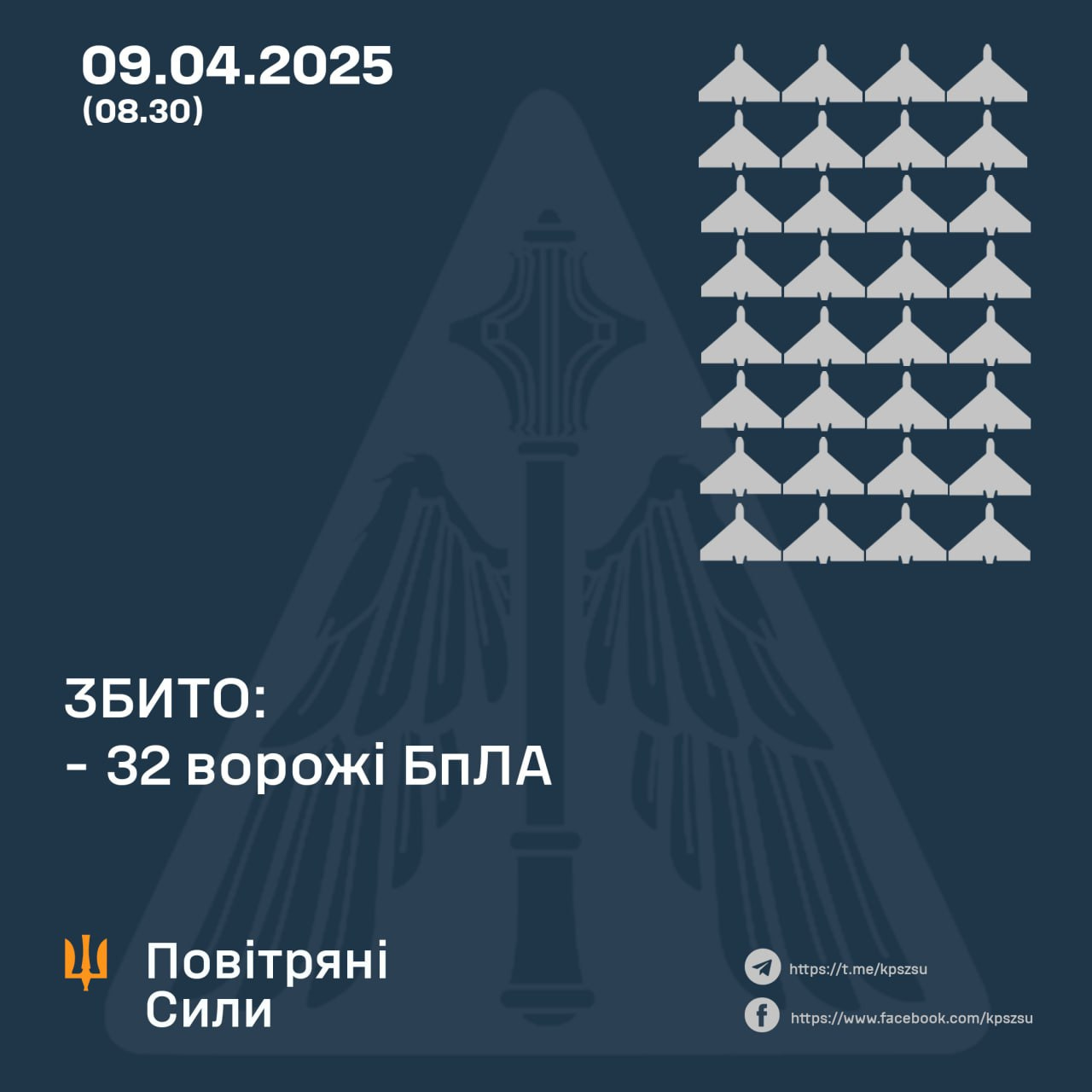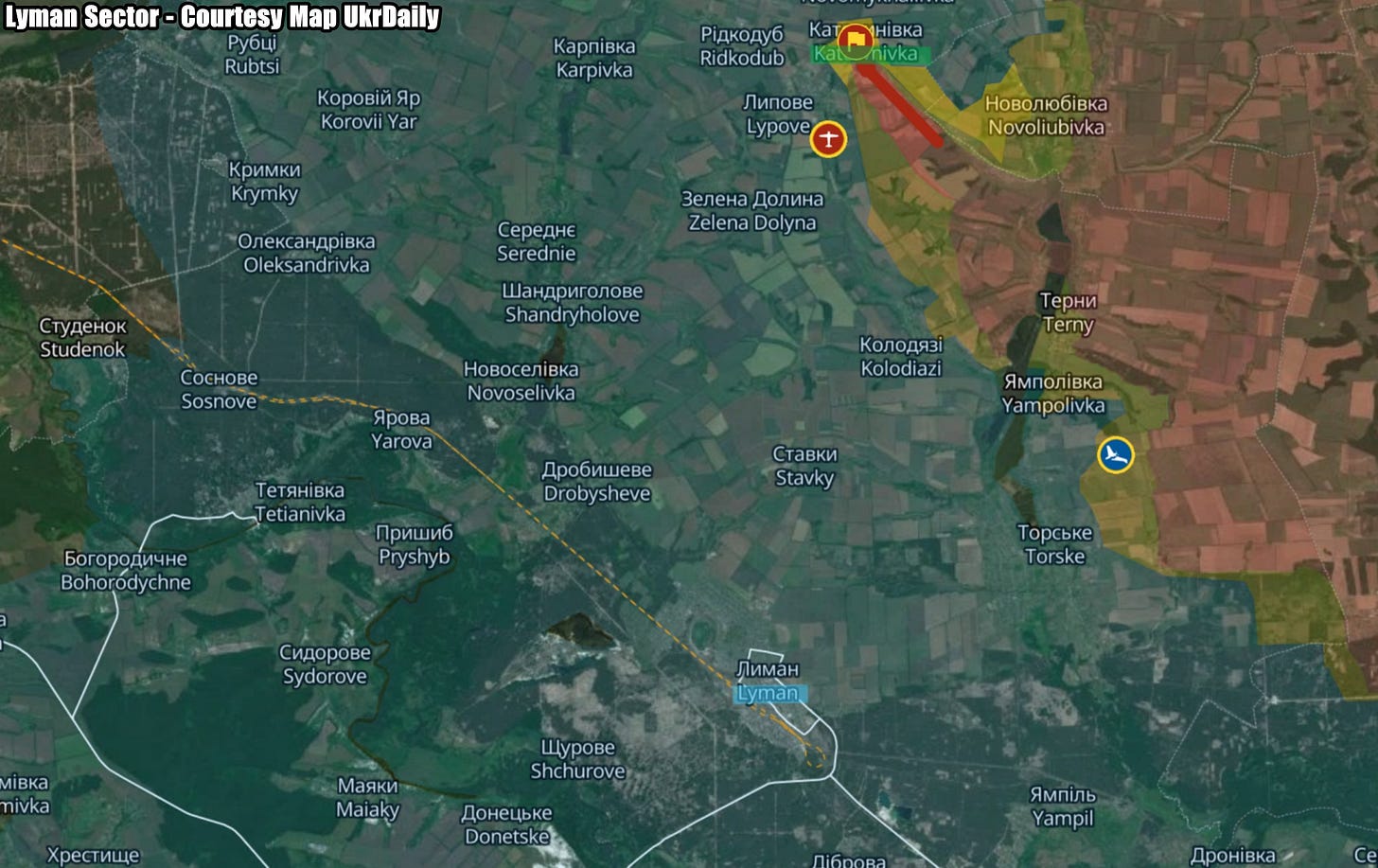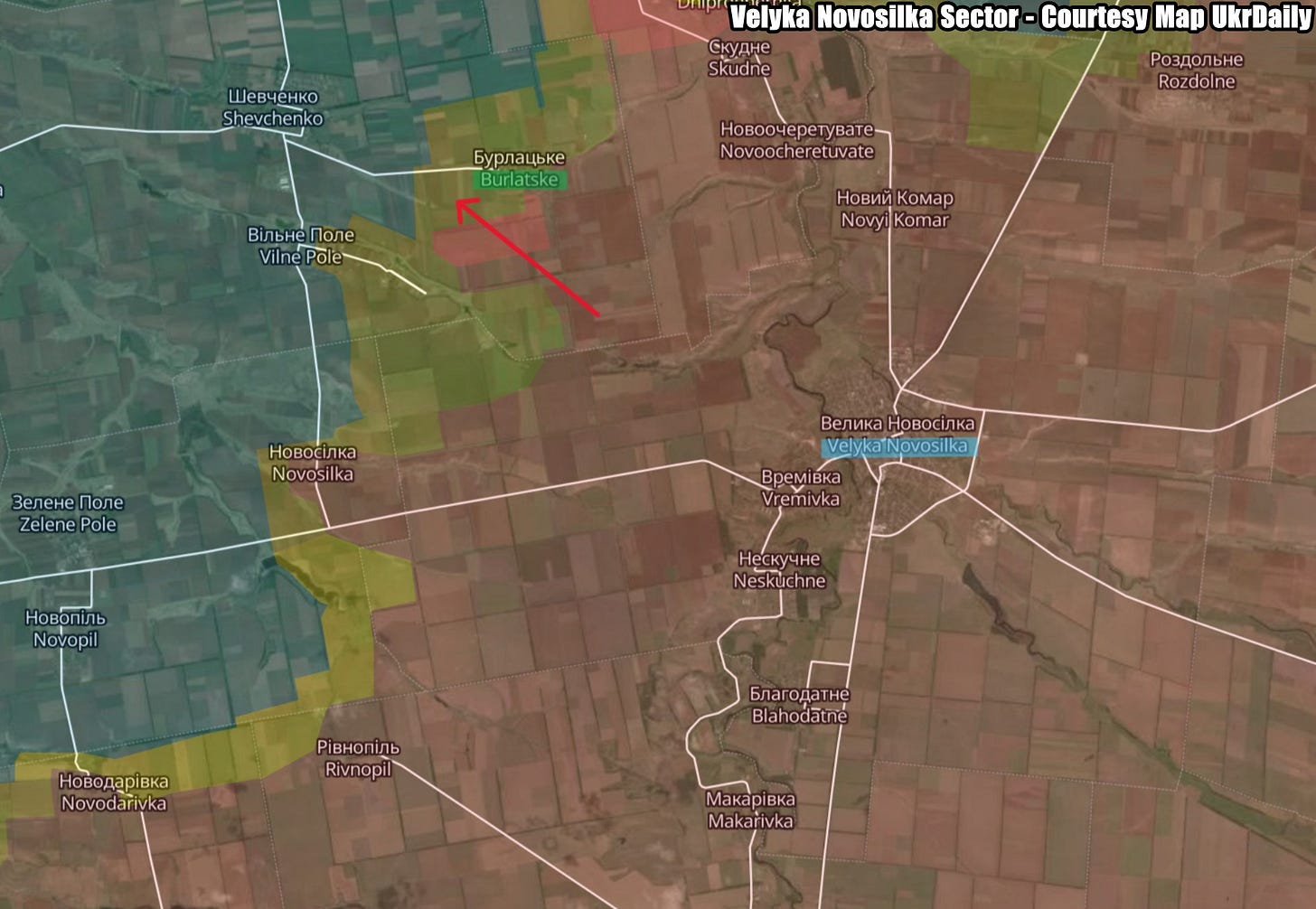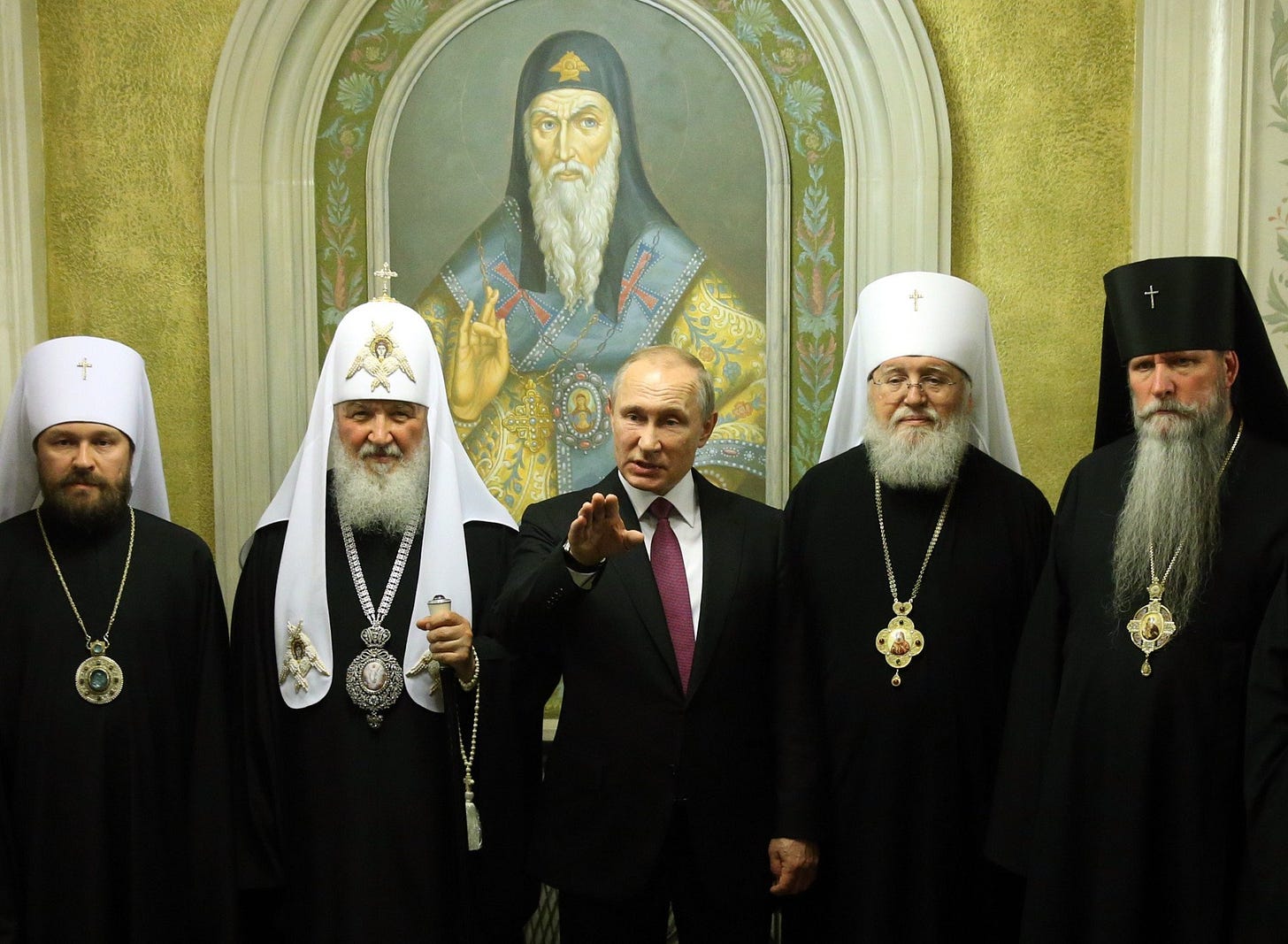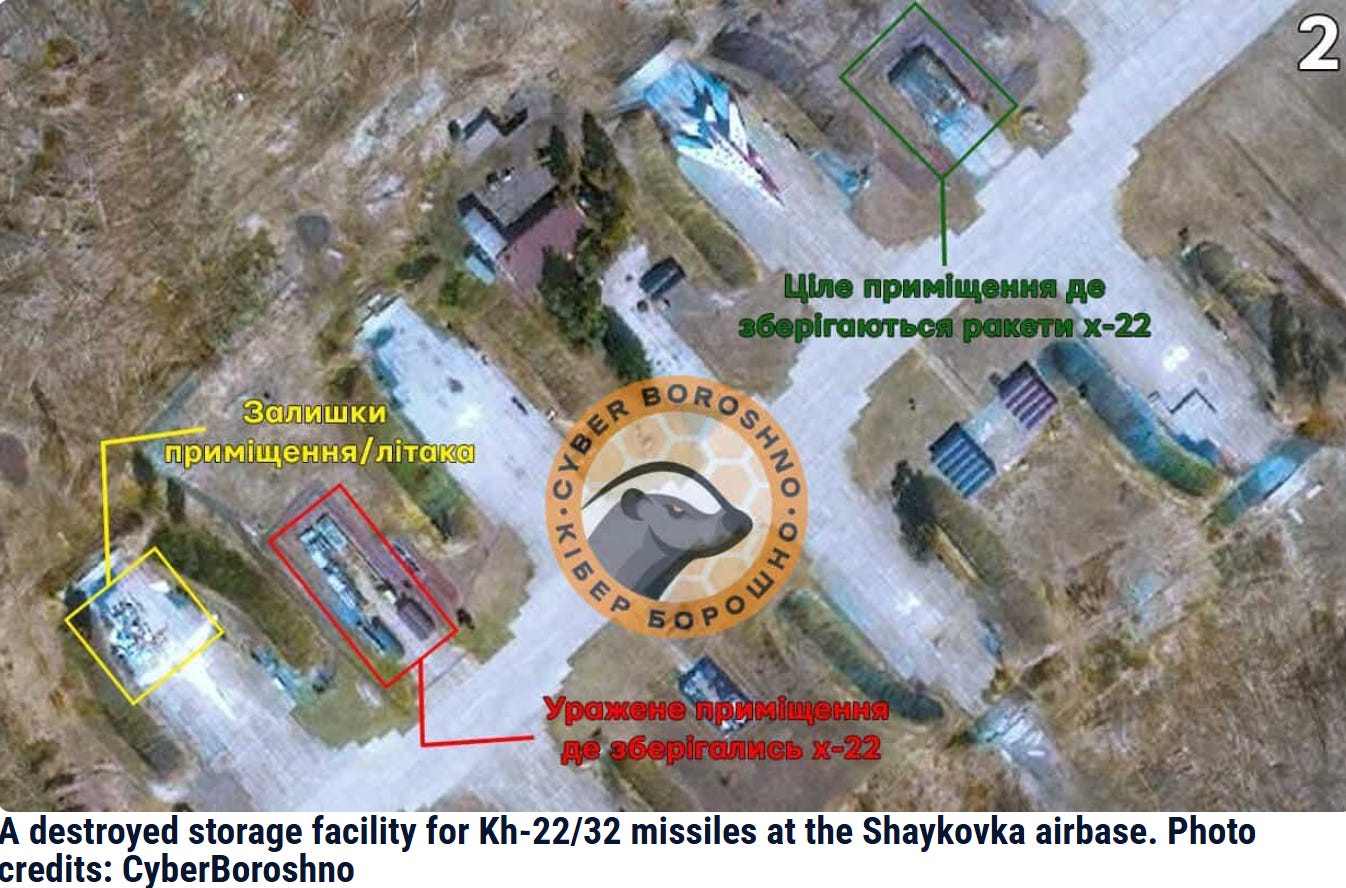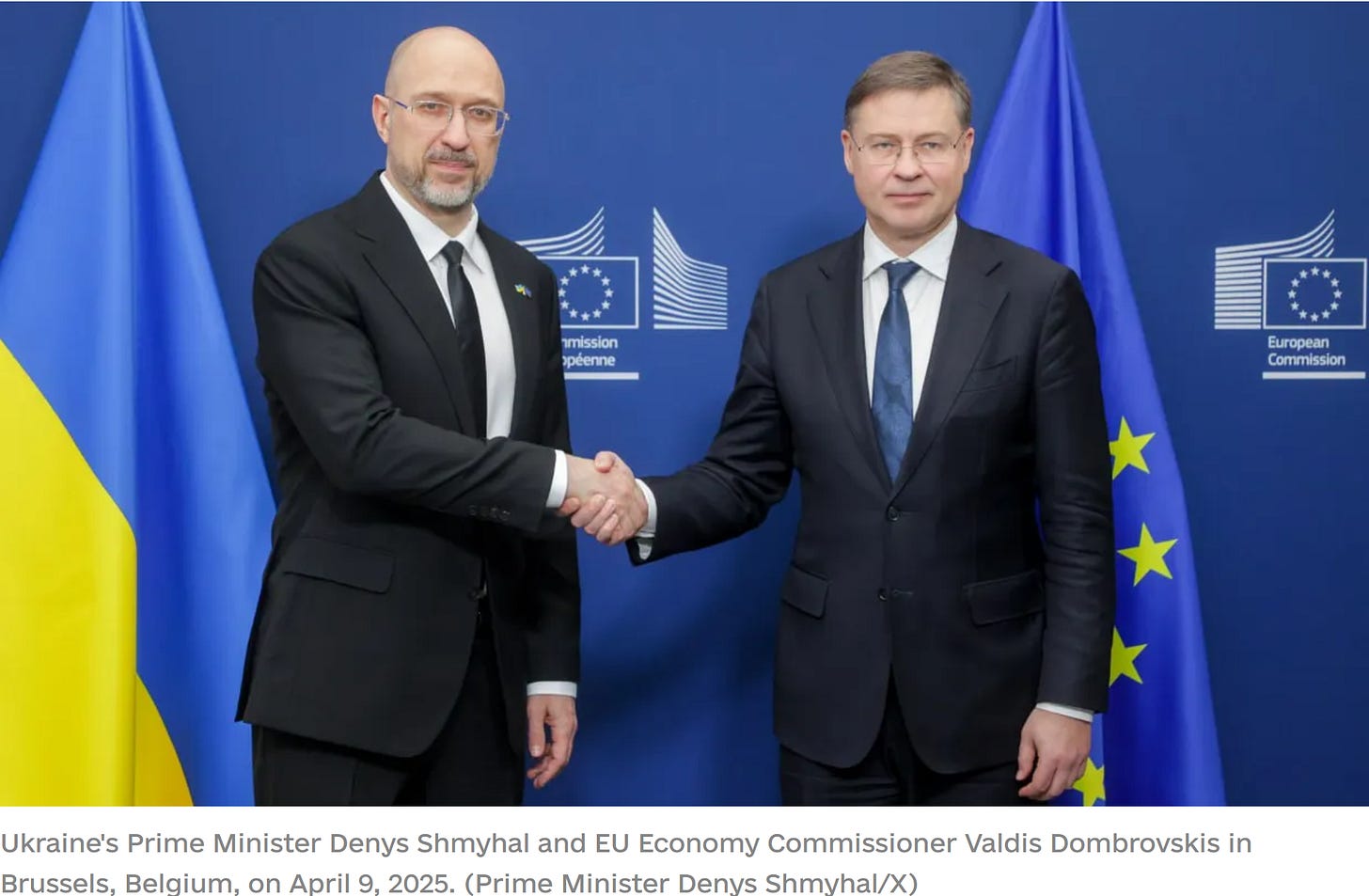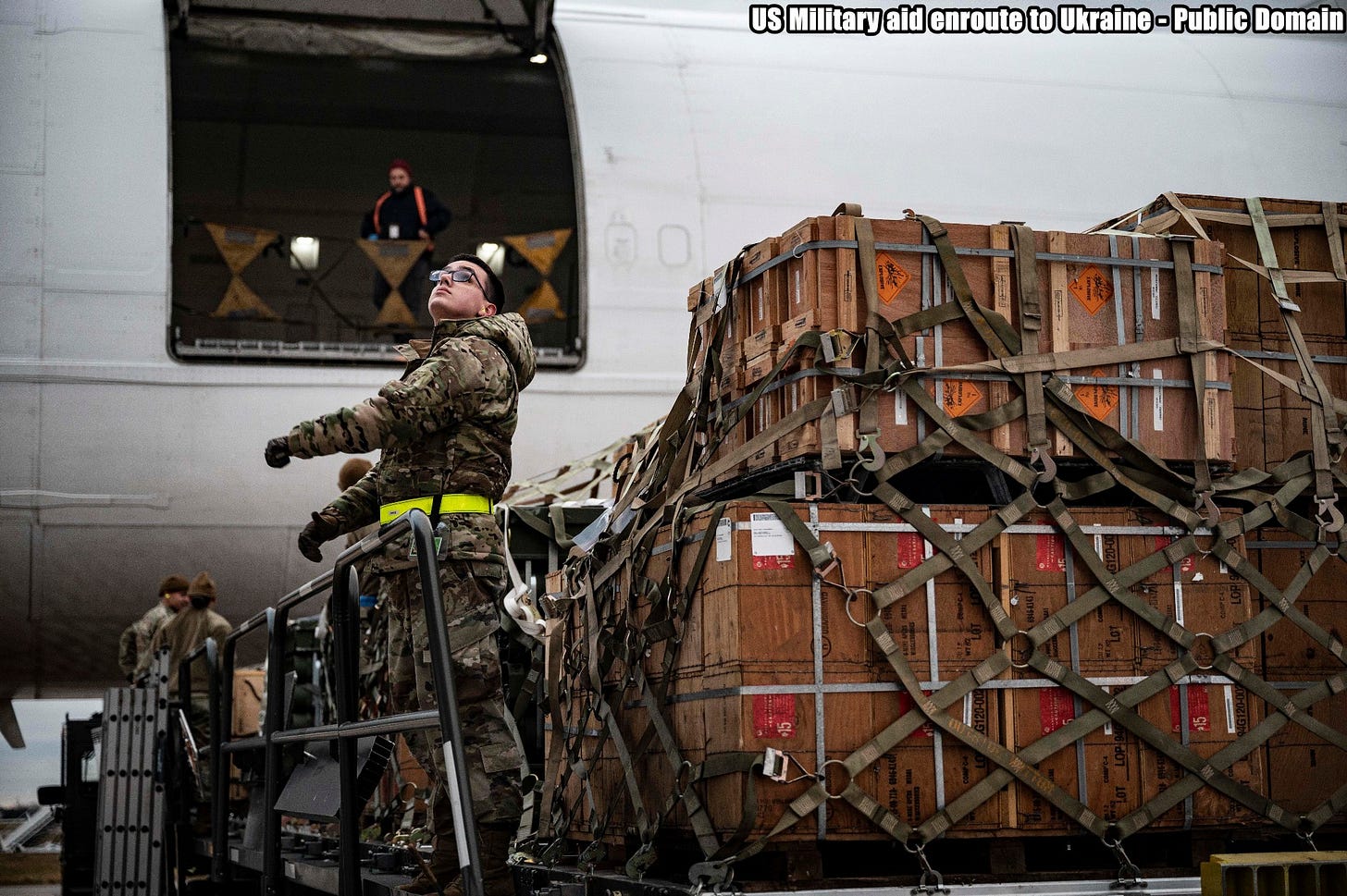Slava Ukraini! In early 2022 I began a Telegram channel aggregating news from a number of sources daily on the war in Ukraine. In June 2023 I began providing a daily draft for the Ukraine War Brief Podcast collecting news from over 70 sources daily, which formed the basis of the script. While the Podcast no longer exists I have continued to make this Brief available for my followers here on Substack for those who wish to keep up with the news from the war.
All the latest news on the Russo-Ukraine War 6 days per week
ALONG THE CONTACT LINE
GSAFU Morning Report
For: Apr 9, 2025
The General Staff of the Armed Forces of Ukraine in its Operational Information update at 08:00 on Apr 9 stated that day 1141 of the full-scale invasion of the Russian Federation against Ukraine had begun.
The situation on the line of combat remains tense in some sectors. Ukrainian defenders continue to actively counteract the Russian aggressor, causing them significant losses in personnel, equipment and technology. Exhausting the enemy along the entire front line and continuing to disrupt the plans of Russian occupiers to advance deeper into the territory of Ukraine.
During the past day, 161 combat engagements took place.
Over the past 24 hours, the enemy carried out 1 missile strike, 91 air strikes, used 2,180 drones and fired approximately 4,900 artillery shells across the positions of Ukrainian forces and civilians.
Air Force Daily Report
32 ENEMY UAVS SHOT DOWN, 8 SIMULATOR UAVS FAILED TO REACH THEIR TARGETS (LOCATIONALLY LOST)
➖➖➖➖➖➖➖➖➖
On the night of Apr 9, 2025 (from 8:00 p.m. on Apr 8), the enemy attacked with 55 Shahed attack UAVs and simulator drones of various types from the directions: Kursk, Millerovo, Primorsko-Akhtarsk - Russia, Chauda - Crimea.
The air attack was repelled by aviation, anti-aircraft missile troops, electronic warfare units, and mobile fire groups of the Defense Forces of Ukraine.
As of 08:30, it has been confirmed that 32 Shahed attack UAVs (and other types of drones) have been shot down in the north and east of the country.
8 enemy drone simulators — lost in location (without negative consequences).
The Kharkiv and Dnipropetrovsk regions were affected by the Russian attack.
Combat Operations in the Russian Federation
The Institute for the Study of War (ISW), a US based think tank, in its Apr 8 Russian Offensive Campaign Assessment reported that:
Kursk Salient: Russian forces recently advanced in Kursk Oblast amid continued fighting in the Kursk-Sumy Oblast border area.
Geolocated footage published on Apr 7 indicates that Russian forces advanced along a road northwest of Guyevo (south of Sudzha) during a reinforced platoon-sized mechanized assault.
Belgorod Incursion: Russian forces recently marginally advanced in Belgorod Oblast.
Geolocated footage published on Apr 8 indicates that Russian forces recently marginally advanced in southwestern Demidovka (northwest of Belgorod City).
The Khortytsia operational-strategic group
(Responsible for the northeastern part of Ukraine. )
Lyman Sector: Russian forces recently advanced in the Lyman direction.
Assessed Russian advances: Geolocated footage published on Apr 8 shows elements of the Russian 144th Motorized Rifle Division, 20th Combined Arms Army [CAA], Moscow Military District [MMD]) raising a flag in northwestern Katerynivka (northeast of Lyman), indicating that Russian forces have likely seized Katerynivka.
Toretsk Sector: Russian forces recently advanced in the Toretsk direction.
Geolocated footage published on Apr 7 indicates that Russian forces recently advanced in fields northwest of Toretsk.
The Tavria operational-strategic group
(Responsible for the central-eastern and southeastern part of Ukraine.)
Pokrovsk Sector : Russian forces are currently pursuing three distinct tactical objectives in the Pokrovsk direction, but Ukrainian drone operations and localized counterattacks are continuing to complicate Russian advances in the area. Ukraine's Khortytsia Group of Forces Spokesperson Major Viktor Trehubov stated on Apr 7 that Russian forces are trying to cut the T-0504 Pokrovsk-Kostyantynivka highway northeast of Pokrovsk, bypass Pokrovsk from the west, and attack in the Novopavlivka (southwest of Pokrovsk) direction.
Russian forces are making limited gains northeast of Pokrovsk toward the T-0504 highway and southwest of Pokrovsk toward Novopavlivka but appear to be struggling to advance immediately south and southwest of Pokrovsk — where Ukrainian forces have focused most of their counterattacks in February, March, and early Apr 2025.
Russian advances northeast of Pokrovsk support both the ongoing Russian effort to envelop Pokrovsk from the east and west and the effort to pressure Kostyantynivka from the south by advancing along the T-0504 highway and eliminating the Ukrainian salient southwest of Toretsk.
The situation immediately south and southwest of Pokrovsk remains extremely dynamic amid intensified Russian offensive operations and localized Ukrainian counterattacks and drone operations in the area.
Velyka Novosilka Sector: Russian forces recently advanced in the Velyka Novosilka direction.
Geolocated footage published on Apr 8 indicates that Russian forces recently advanced northwest of Burlatske (northwest of Velyka Novosilka).
The Odesa operational-strategic group
(Responsible for Kherson, Qırım, (also known as Crimea) and the Black Sea.)
There have been no major changes to the combat environment since our last report.
TEMPORARILY OCCUPIED TERRITORIES
The Russian Orthodox Church used to repress Ukrainians in the occupied territories.
The UK Ministry of Defence in their Apr 8 Russian Occupation update stated that The Kremlin is using the Russian Orthodox Church (ROC) to consolidate social control over occupied areas of Ukraine and destroy any semblance of religious freedom. Russian opposition outlet Novaya Gazeta Evropa published a report on April 3 detailing how the Kremlin-controlled ROC is targeting religious communities, particularly those affiliated with the Orthodox Church of Ukraine (OCU), thereby serving as a tool of the Russian occupation administration throughout occupied Ukraine.
Novaya Gazeta Evropa found that Russian shelling and airstrikes, as well as bans and other repressive measures, decreased the total number of religious communities in occupied Luhansk, Donetsk, Zaporizhia, and Kherson oblasts from 1,957 before the full-scale invasion to 902 currently operating. This figure does not include data on religious communities in occupied Crimea, which have faced Russian religious oppression for over a decade.
Novaya Gazeta Evropa noted that Ukrainian Christians, especially members of the OCU, face particularly intense oppression at the hands of the ROC. The investigation found that over 51 percent of churches destroyed since 2022 have been OCU churches, likely because the ROC sees the OCU as its biggest “competitor.” The OCU has been entirely independent from the ROC Moscow-Patriarchate since 2019.
The ROC frequently seizes OCU churches that remained undamaged and appropriates them for ROC services or to cater to the needs of occupying Russian military personnel. Russian forces have also kidnapped, tortured, deported, and even killed OCU priests in a campaign of “systemic repression” against OCU clergy.
Novaya Gazeta Evropa found that as a result of the ROC’s repressive policies, OCU functions in occupied Ukraine have “been completely stopped.” Novaya Gazeta Evropa also found that Russia has essentially “eliminated” the presence of non-Orthodox religious communities in occupied Ukraine, including those associated with Catholicism, Protestantism, Islam, Judaism, and Buddhism, with Catholic and Protestant communities facing types and levels of oppression similar to those the OCU faces. ISW has reported at length on Russian efforts to persecute religious minorities, particularly Christian communities, in occupied Ukraine as part of the Kremlin’s wider occupation campaign.
THE HOME FRONT
Experts Record Surge in Cyber Espionage Against Ukrainian Military and Defense Industry.
Cyber specialists have recorded an increase in attempts of cyber espionage targeting Ukrainian institutions involved in the development of military innovations, using spyware programs. Militarnyi reports.
CERT-UA reported on this, the specialized cybersecurity team of the State Center for Cybersecurity of Ukraine.Since the beginning of February 2025, the Computer Emergency Response Team (CERT-UA) has been documenting targeted cyber activity that exhibits signs of cyber espionage. The targets of these attacks are Ukrainian institutions involved in military developments and technological innovations.
Military units, law enforcement agencies, and local government authorities, particularly those located near Ukraine’s eastern border, are also under increased focus by cybercriminals.
The main tool of the attacks is email, to which Excel files are attached. The subject lines of the emails and the file names mention socially sensitive topics: demining, administrative fines, UAV production, compensation for destroyed property, etc.
The Excel documents contain hidden malicious code. After opening the file and activating macros, the code automatically turns into malware and runs without the user’s knowledge.
The experts pay special attention to the fact that the emails are sent from already compromised accounts. In many cases, web interfaces of email clients are used.
In this regard, CERT-UA urges system administrators to check the completeness and availability of event logs on mail and web servers. This will help to promptly detect traces of attacks and prevent their consequences..
It is worth reminding that in October 2024, the Ministry of Defence of Ukraine established a separate structural unit responsible for cyber defense – the Cyber Incident Response Center.
“The creation of the Cyber Incident Response Center at the Ministry of Defence is an important and necessary step for a country that is at war and defending itself. The enemy is pressuring not only on the front line but also in the digital battlefield. The aggressor is trying to slow down our rapid development. The Center will help improve the state of cybersecurity and ensure proper response to cyber incidents,” said Deputy Minister of Defence for Digitalization Kateryna Chernohorenko.
In addition, the creation of Cyber Forces as a separate branch of the military within the structure of the Armed Forces of Ukraine is being discussed in the Ukrainian Defense Forces.
RUSSIAN WORLD
Russian Central Bank Warns Falling Oil Prices Could Squeeze Budget.
Russia’s Central Bank chief warned Tuesday that falling global oil prices could strain the country’s public finances, raising hopes among some in Ukraine that Moscow’s ability to fund its war effort would be hampered as a result, the Moscow Times reports.
Oil prices have slid amid mounting recession fears fueled by U.S. President Donald Trump’s aggressive tariff policies. Energy revenues make up roughly one-third of Russia’s annual budget.
Trade wars “usually lead to declining global trade and... perhaps [falling] demand for our energy resources,” Central Bank chief Elvira Nabiullina told Russian lawmakers. “The risks are there,” she said, adding that “we always prepare for such risks.”
Russia’s oil revenues fell 10% year-on-year in the first quarter to $31 billion, the Finance Ministry said Tuesday, warning of further declines “due to the weakening price environment.”
Ukraine, which has long criticized countries that continue to buy Russian energy, said Monday it hoped the price drop would squeeze the Kremlin’s war budget.
“The lower the oil prices, the less money Russians will have to fund their war,” Andriy Yermak, chief of staff to Ukrainian President Volodymyr Zelensky, wrote on social media.
Russia’s benchmark Urals crude was trading near $50 a barrel, down 15% since March and at its lowest level since 2023, according to market data.
President Vladimir Putin said last year that Russia was spending nearly 9% of its GDP on defense and security, a level not seen since the late Soviet era.
Economist and investor Yevgeny Kogan told AFP that while defense spending could take a hit, any impact would likely be limited and delayed.
“There may be a decline, but a minor one and probably not in the moment,” he said.
Russia’s financial reserves remain strong. As of March 1, the country’s National Welfare Fund — a rainy-day fund built up from years of oil profits — held around $138 billion in assets. Roughly $39 billion of that is considered “liquid” and can be readily sold to raise cash.
Asked about the falling oil prices, Kremlin spokesman Dmitry Peskov said Monday that Russian authorities are “very closely watching in order to minimize the consequences of the economic storm.”
Russian Tu-22M3 destroyed by drone immediately after landing.
A strike drone of the Ukrainian Defense Forces destroyed a Russian Tu-22M3 strategic bomber, Militarnyi reported on Apr 9.
Oleksandr Syrskyi, the Commander-in-Chief of the Armed Forces of Ukraine, stated the following during an interview with LB.ua.
“Several days ago, through our successful actions, we destroyed a long-range bomber Tu-22M3. It had just landed — and our drone hit it. Its value is about $100 million,” Syrskyi shared.
According to the information available to the Commander-in-Chief, the Ukrainian drone was able to hit the Russian Tu-22M3 strategic bomber immediately after it landed at the Shaykovka airbase, located in the Smolensk region of Russia.
The airbase is home to Tu-22M3 strategic bombers of the 52nd Heavy Bomber Aviation Regiment of the Russian Federation, involved in missile strikes on the territory of Ukraine with Kh-22/Kh-32 missiles.
Recently, the CyberBoroshno cyber community published satellite images of this airfield, which showed signs of strikes by Ukrainian drones.
In one of the images, strange remains were spotted, which were classified as a destroyed aircraft or building. The remains are located at the parking area where aircraft are usually based.
Given the satellite images and the statement of the Commander-in-Chief, it appears that the Ukrainian Defense Forces managed to destroy the Russian Tu-22M3.
Militarnyi previously reported that strike drones destroyed a depot with Kh-22/32 missiles and a technical facility for their maintenance during an attack on the Shaykovka air base.
Drones attacked the airbase, where the Tu-22M3 strategic bombers are based, at night on March 31, 2025.
The strike damaged the airbase’s infrastructure, primarily destroying the Kh-22/32 missile preparation room, where the missiles were refueled and set up before launch.
It should be noted that Ukrainian long-range drones targeted this air base at least three times — in September 2024, August 2023, and October 2022.
Drones Attack Military Air Base Near Orenburg for the First Time.
For the first time, drones have attacked the Russian military air base near Orenburg, located more than 1,000 kilometers from the Ukrainian border, Militarnyi reports.
Regional authorities reported this, with videos of the drone flights shared by local social media pages.
According to Astra, the Orenburg-2 military air base was the focus of the drone strike.
Yevgeny Sontsov, the region’s governor, stated that the Russian air defense forces allegedly shot everything down. A photo of the wreckage of one drone was also published.
Open sources indicate that the Orenburg-2 military air base is home to the 117th Military Transport Aviation Regiment of the 18th Guards Military Transport Aviation Division of the Russian Federation. It also hosts the 7th Separate Engineer-Airfield Battalion, which services aircraft and airfield equipment.
On the night of April 9, drones also attempted to attack the military airbase in Mozdok, located in North Ossetia. The head of the republic stated that there were no casualties or damage.
In the Saratov region, according to Shot, explosions were heard in the city of Engels, near the base of the Russian Tu-95MS and Tu-160 strategic bombers, which carry out missile strikes on Ukraine.
According to Astra, in the Penza region of the Russian Federation, the Serdobsky district, which houses a missile and artillery weapons arsenal, was targeted by drones.
In the morning, the Ministry of Defense of the Russian Federation also confirmed the attack by nearly 160 Ukrainian drones on various regions. The attack lasted for 10 hours and ended at 6 a.m. Moscow time.
It is claimed that most drones were shot down over the Krasnodar Krai – 67, Rostov region – 29, and North Ossetia – 15. Drones also targeted the Voronezh, Kursk, Belgorod, Penza, Nizhny Novgorod, Saratov, Orenburg, Oryol regions, the Stavropol Krai, and the annexed Crimea.
RELATED INTERNATIONAL NEWS
Lobbying Budgets may explain US Government’s swing in support to Russia.
Ukraine spent $62,500 on lobbying efforts in the U.S. in 2024, seven times less than Russia's $461,200, the Kyiv Independent reported citing data published by the Ukrainian analytics platform Opendatabot on April 9.
The platform noted a sharp decline in Ukraine's lobbying expenditures, which dropped sixfold compared to 2023. Opendatabot highlighted that several countries, including Poland and Russia, have also slashed their U.S. lobbying budgets in 2024.
Poland spent $245,200 — five times less than the year before — and Russia reduced its lobbying costs eighteenfold but still spent 7.4 times more than Ukraine.
Since the start of Russia's full-scale invasion in 2022, Ukraine has spent over $5.4 million to advocate for continued U.S. military and financial support, while Russia invested $11.8 million over the same period — more than double.
Despite the cuts, Ukrainian officials and advocacy groups have remained active in engaging U.S. lawmakers, think tanks, and the media to secure ongoing aid.
In March, President Volodymyr Zelensky signed a law regulating the lobbying market in Ukraine for the first time, defining the practice and setting formal procedures for lobbying activities. The move is part of broader transparency reforms tied to Ukraine's European integration efforts.
Grumpy here - Let us for a moment ponder how it appears the amount of money one spends lobbying US lawmakers seems to directly affect the decisions of said American lawmakers. In most sensible countries this would be viewed as corruption, in the US this is just the cost of doing business.
EU transferring new $1-billion tranche for Ukraine covered by frozen Russian assets.
The EU is allocating another financial assistance tranche of 1 billion euros ($1.1 billion) as part of the G7 loan program for Ukraine, the Kyiv Independent reports citing an announcement by Prime Minister Denys Shmyhal on April 9.
"We are grateful to our partners for supporting the economy and the rapid recovery of our country," Shmyhal said after meeting EU Economy Commissioner Valdis Dombrovskis in Brussels.
Western nations froze around $300 billion in Russian assets after Moscow launched its full-scale invasion of Ukraine in February 2022, with roughly two-thirds held in Europe.
Kyiv has been urging its foreign partners to confiscate the assets and funnel them to Ukraine's defense and reconstruction efforts, but Western leaders have been hesitant to take the step, fearing legal, political, and economic pitfalls.
Instead, the G7 members agreed to provide Kyiv with a $50 billion Extraordinary Revenue Acceleration (ERA) loan, which will be repaid with proceeds from the frozen assets.
The EU is providing around 18.1 billion euros ($20 billion) as part of the loan, with another $20 billion shouldered by the U.S. and the rest by the U.K., Canada, and Japan.
"We are delivering on our promise to support Ukraine," Dombrovskis said. "This (aid) provides crucial financing to Ukraine and makes Russia pay for its aggression."
US aid has dropped, main support comes from Europe, Syrskyi says.
U.S. military assistance to Kyiv has decreased, with European countries now providing the main portion of aid, Commander-in-Chief Oleksandr Syrskyi said in an interview with the LB.UA outlet published on April 9, the Kyiv Independent reports.
Washington has been Kyiv's leading military donor throughout the full-scale war, but President Donald Trump's accession to office brought a major shift in U.S. policy on the Russia-Ukraine war.
Trump has permitted the continued flow of assistance approved by former U.S. President Joe Biden – except for a brief halt on all military aid in March – but has yet to sign off on any new packages.
"Support from partners, of course, plays a crucial role (in changing the strategic situation in the war)," Syrskyi said in the interview. The U.S. provided Ukraine with some $100 billion in military aid since the outbreak of Russia's full-scale war in 2022, including $67 billion in arms.
"Now, the assistance from the U.S. has decreased, and the main support comes from our partners in Europe," the commander added.
A number of European countries have pledged further aid packages for Ukraine amid the growing uncertainty about U.S. support. The Trump administration has also urged Europe to increase its share of aid for Ukraine and take more responsibility for its own security.
"But we must also rely on our own strength. We have had success in the production of artillery and quite significant successes with electronic warfare," Syrskyi said. "Drones as well. So many types, models of drones used to strike (Russia) at the tactical, operational, and strategic levels."
Aiming to reduce its reliance on foreign support, Ukraine has ramped up its domestic defense production over the past years. The country's 2025 budget allocated Hr 55 billion ($1.3 billion) for weapons production.
President Volodymyr Zelenskyy said in February that around 40% of the weapons and equipment Ukraine uses on the battlefield are Ukrainian-made, while the U.S. contributes roughly 30%.
MILITARY & TECH
Ukraine unveils new drone designed to intercept Russian-used Shaheds.
Ukraine unveiled a domestically developed drone designed to intercept and destroy Iranian-designed Shahed drones used by Russia, the Ukrainian outlet Militarnyi reported on April 9.
According to its designers, the drone has already been deployed in combat and has successfully destroyed more than 20 Shahed-type drones over the past two months.
The designers said this is the most effective interceptor drone currently in service with the Armed Forces. The system is also capable of targeting reconnaissance drones.
The interceptor drone's maximum flight speed is 200 kilometers per hour (approximately 124 miles per hour), and it can operate at altitudes up to 5 kilometers (about 3.1 miles).
Unlike traditional air defense systems that rely on costly anti-aircraft missiles, the new drone offers a cheaper and more sustainable option for downing low-speed, small-sized targets.
Russia has extensively used Shahed drones since late 2022, particularly the Shahed-136 model, to strike critical infrastructure and civilian areas across Ukraine. The low-flying, self-detonating drones have become a central element of Russia's long-range strike tactics.
The Ukrainian drone was showcased to Belgian Prime Minister Bart de Wever during his visit to Kyiv on April 8. De Wever visited Bucha in Kyiv Oblast and met with President Volodymyr Zelensky earlier in the day.
Kyiv has prioritized the development of high-performance, low-cost domestic defense technologies to improve protection and reduce dependence on Western-supplied missile systems.
That’s it for today’s Brief folks if you would like to keep up with events in Ukraine daily please consider subscribing, it’s free!







